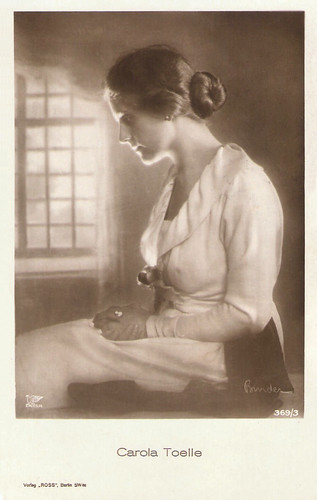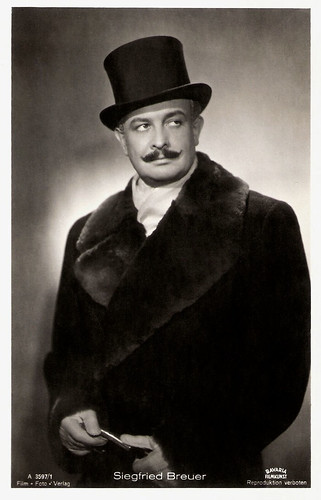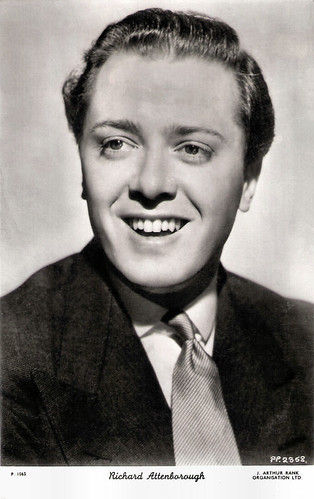A friend who contributes lots and lots of postcards to this site is Didier Hanson. From Spain, he regularly sends me new scans of vintage film postcards he discovered. His collection must be gigantic, but the quality is even more impressing. Time after time, a film museum or a collector writes me how amazed they are about Didier's Russian Vera Kholodnaya cards or about the Hungarian postcard of the young Bela Lugosi (photo: Angelo). Didier himself is also a huge fan of silent diva Lya de Putti, because she reminds him of his wife. But he also likes vintage postcards of forgotten actors of the silent European cinema, many of whom were dancers. This post presents some of these rare cards, he has sent me recently.
![Brigitte Helm in Metropolis]()
German postcard by Ross Verlag, Berlin, no. 71/1. Photo: Ufa / Parufamet. Publicity still for Metropolis (Fritz Lang, 1927) with Brigitte Helm. Collection: Didier Hanson. Tomorrow, EFSP will start a new series of weekly film specials in which Metropolis will be included.
![Wege zu Kraft und Schönheit]()
German postcard by Ross Verlag, Berlin, no. 24/4. Photo: Ufa. Publicity still for Wege zu Kraft und Schönheit/Ways to Strength and Beauty (Nicholas Kaufmann, Wilhelm Prager, 1925). Collection: Didier Hanson.
![Elsa Krüger]()
German postcard by Georg A. Jasmatzi Aktiengesellschaft, Dresden. Photo: H. Philipp, Paris. Collection: Didier Hanson.
Russian dancer and actress Elsa Krüger (1893-1941) started to perform in modern dances in 1913. Soon she was a star, named 'queen of tango'. She starred in one of the best films of the Russian empire, Nemye svideteli/Silent Witnesses (Yevgeny Bauer, 1914) as the attractive, cold-hearted, manipulative Yelena. After the revolution, she opened the Russian Romantic Ballet Theatre (Russische romantische Ballett) in Berlin and also appeared in a few German films.
![Vera Malinowskaja]()
German postcard by Ross Verlag, no. 4386/1, 1929-1930. Photo: Atelier Balázs, Berlin. Collection: Didier Hanson.
Vera Malinovskaya (1900-1988), also written as Malinovskaja/ Malinovskaia, played in several Russian films of the 1920s and a few in Germany and Austria.
![Leni Riefenstahl]()
German postcard by Ross Verlag, no. 1626/1, 1927-1928. Photo: Ufa / Parufamet. Collection: Didier Hanson.
Leni Riefenstahl (1902-2003) was the notorious director of Triumph des Willens (1935), a fascinating propaganda documentary about Adolf Hitler and the Third Reich, commissioned by the Nazi government. Before she started directing films, she worked as a dancer and on screen she became a star in the mountain films, directed by Arnold Fanck.
![Hanna Ralph]()
German postcard by Ross Verlag, no. 2054/1, 1927-1928. Photo: Ernst Schneider, Berlin. Collection: Didier Hanson.
Stage actress Hanna Ralph (1885-1978) had also a prominent career in the silent cinema. She is best known as Brunhild in Fritz Lang's Die Nibelungen: Siegfried (1924). She also appeared in F.W. Murnau's Faust - Eine deutsche Volkssage (1926) and was married to its star, Emil Jannings.
![Ernest Tautenhayn]()
Austrian postcard by Iris-Verlag, no. 47. Photo: Residenz. Collection: Didier Hanson.
Austrian actor Ernst Tautenhayn (1874–1944) appeared in silent films of the late 1910s and early 1920s.
![Hermann Picha]()
Austrian postcard by Iris-Verlag, no. 522. Photo: Sascha-Film, Wien (Vienna). Collection: Didier Hanson.
German actor Hermann Picha (1865-1936) played character roles in many classics of the Weimar cinema, such as Fritz Langs's Der müde Tod/Destiny (1921), F.W. Murnau's Herr Tartüff/Tartuffe (1925), and Der Hauptmann von Köpenick/The Captain from Koepenick (Siegfried Dessauer, 1926).
![Lili Darvas]()
Austrian postcard by Iris-Verlag, no. 455. Photo: Ernst Förster, Wien (Vienna). Collection: Didier Hanson.
Hungarian-born Lili or Lilly Darvas (1902-1974) was a major star first in Budapest, then on the German stage with Max Reinhardt's theatre company during the 1920s. In 1926, Lili married the playwright Ferenc Molnár, who wrote several plays for her.The following year, she made her Broadway debut as Titania in A Midsummer Night's Dream. After the Austrian Anschluss in 1938, the Jewish actress fled to the US. In Hollywood, she appeared in the MGM musical Meet Me in Las Vegas (Roy Rowland, 1956).
![Jeanette Loff]()
German postcard by Ross Verlag, no. 4596/1, 1929-1930. Photo: PDC. Collection: Didier Hanson.
American beauty Jeanette Loff (1906-1942) made her film debut in Uncle Tom's Cabin (Harry A. Pollard, 1927) . Cecil B. Demille offered her a contract and she quickly became one of Hollywood busiest starlets. Jeanette got the chance to show off her soprano voice in films like King Of Jazz (John Murray Anderson, 1930) and Party Girl (Victor Halperin, 1930). Later she starred in several Broadway shows. She retired from acting and in 1942 she died after ingesting ammonia. She was only thirty-five years old.
![Lydia Johnson]()
Italian postcard, no. 28. Photo: Macari. Collection: Didier Hanson.
Russian actress Lydia Johnson (1896-1969) made a few films in Russia, just before the revolution started. She fled to Turkey and finally settled in Italy.
![Friedrich Zelnik and Erich Kaiser-Titz in Die Rose von Dschiandur]()
German postcard by Verlag Hermann Leiser, Berlin-Wilm., no. 3214. Photo: publicity still for Die Rose von Dschiandur/The Rose of Dschiandur (Alfred Halm, 1918) with Friedrich Zelnik and Erich Kaiser-Titz. Collection: Didier Hanson.
Muchos gracias, amigo!
Sources: Verbinina and IMDb.

German postcard by Ross Verlag, Berlin, no. 71/1. Photo: Ufa / Parufamet. Publicity still for Metropolis (Fritz Lang, 1927) with Brigitte Helm. Collection: Didier Hanson. Tomorrow, EFSP will start a new series of weekly film specials in which Metropolis will be included.

German postcard by Ross Verlag, Berlin, no. 24/4. Photo: Ufa. Publicity still for Wege zu Kraft und Schönheit/Ways to Strength and Beauty (Nicholas Kaufmann, Wilhelm Prager, 1925). Collection: Didier Hanson.

German postcard by Georg A. Jasmatzi Aktiengesellschaft, Dresden. Photo: H. Philipp, Paris. Collection: Didier Hanson.
Russian dancer and actress Elsa Krüger (1893-1941) started to perform in modern dances in 1913. Soon she was a star, named 'queen of tango'. She starred in one of the best films of the Russian empire, Nemye svideteli/Silent Witnesses (Yevgeny Bauer, 1914) as the attractive, cold-hearted, manipulative Yelena. After the revolution, she opened the Russian Romantic Ballet Theatre (Russische romantische Ballett) in Berlin and also appeared in a few German films.

German postcard by Ross Verlag, no. 4386/1, 1929-1930. Photo: Atelier Balázs, Berlin. Collection: Didier Hanson.
Vera Malinovskaya (1900-1988), also written as Malinovskaja/ Malinovskaia, played in several Russian films of the 1920s and a few in Germany and Austria.

German postcard by Ross Verlag, no. 1626/1, 1927-1928. Photo: Ufa / Parufamet. Collection: Didier Hanson.
Leni Riefenstahl (1902-2003) was the notorious director of Triumph des Willens (1935), a fascinating propaganda documentary about Adolf Hitler and the Third Reich, commissioned by the Nazi government. Before she started directing films, she worked as a dancer and on screen she became a star in the mountain films, directed by Arnold Fanck.

German postcard by Ross Verlag, no. 2054/1, 1927-1928. Photo: Ernst Schneider, Berlin. Collection: Didier Hanson.
Stage actress Hanna Ralph (1885-1978) had also a prominent career in the silent cinema. She is best known as Brunhild in Fritz Lang's Die Nibelungen: Siegfried (1924). She also appeared in F.W. Murnau's Faust - Eine deutsche Volkssage (1926) and was married to its star, Emil Jannings.

Austrian postcard by Iris-Verlag, no. 47. Photo: Residenz. Collection: Didier Hanson.
Austrian actor Ernst Tautenhayn (1874–1944) appeared in silent films of the late 1910s and early 1920s.

Austrian postcard by Iris-Verlag, no. 522. Photo: Sascha-Film, Wien (Vienna). Collection: Didier Hanson.
German actor Hermann Picha (1865-1936) played character roles in many classics of the Weimar cinema, such as Fritz Langs's Der müde Tod/Destiny (1921), F.W. Murnau's Herr Tartüff/Tartuffe (1925), and Der Hauptmann von Köpenick/The Captain from Koepenick (Siegfried Dessauer, 1926).

Austrian postcard by Iris-Verlag, no. 455. Photo: Ernst Förster, Wien (Vienna). Collection: Didier Hanson.
Hungarian-born Lili or Lilly Darvas (1902-1974) was a major star first in Budapest, then on the German stage with Max Reinhardt's theatre company during the 1920s. In 1926, Lili married the playwright Ferenc Molnár, who wrote several plays for her.The following year, she made her Broadway debut as Titania in A Midsummer Night's Dream. After the Austrian Anschluss in 1938, the Jewish actress fled to the US. In Hollywood, she appeared in the MGM musical Meet Me in Las Vegas (Roy Rowland, 1956).

German postcard by Ross Verlag, no. 4596/1, 1929-1930. Photo: PDC. Collection: Didier Hanson.
American beauty Jeanette Loff (1906-1942) made her film debut in Uncle Tom's Cabin (Harry A. Pollard, 1927) . Cecil B. Demille offered her a contract and she quickly became one of Hollywood busiest starlets. Jeanette got the chance to show off her soprano voice in films like King Of Jazz (John Murray Anderson, 1930) and Party Girl (Victor Halperin, 1930). Later she starred in several Broadway shows. She retired from acting and in 1942 she died after ingesting ammonia. She was only thirty-five years old.

Italian postcard, no. 28. Photo: Macari. Collection: Didier Hanson.
Russian actress Lydia Johnson (1896-1969) made a few films in Russia, just before the revolution started. She fled to Turkey and finally settled in Italy.

German postcard by Verlag Hermann Leiser, Berlin-Wilm., no. 3214. Photo: publicity still for Die Rose von Dschiandur/The Rose of Dschiandur (Alfred Halm, 1918) with Friedrich Zelnik and Erich Kaiser-Titz. Collection: Didier Hanson.
Muchos gracias, amigo!
Sources: Verbinina and IMDb.























































































































































